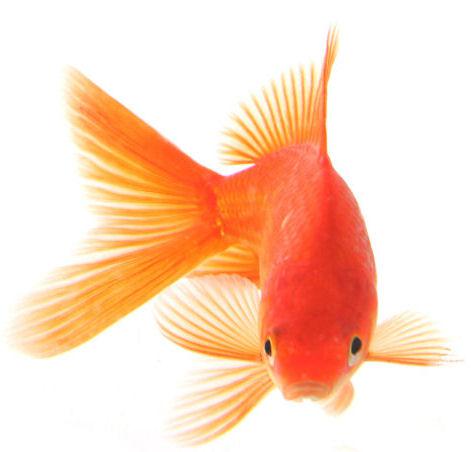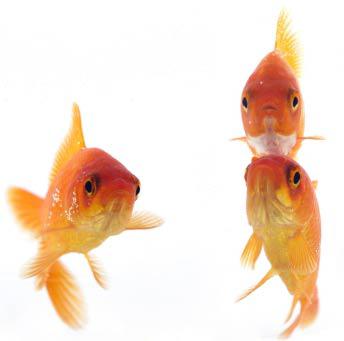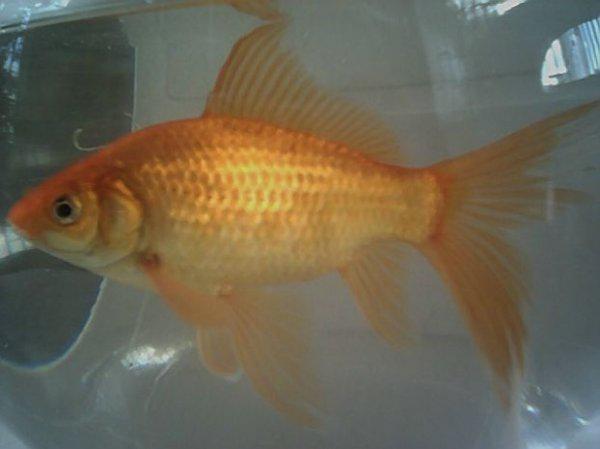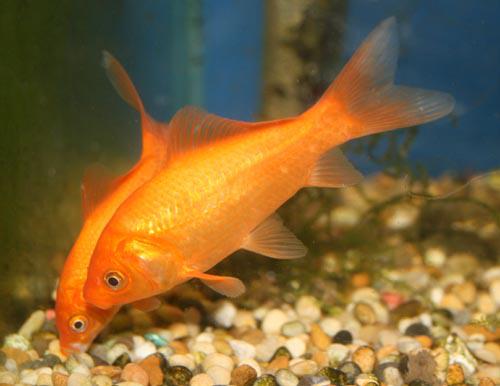Where went goldfish?
 Bashny.Net
Bashny.Net

For centuries sailed convoys toward the rising sun. East attracted fabulous, originality and uniqueness. Being brought from the East cloth, fans, boxes, vases and other products; decorated with extraordinary fish, made a great impression, but the existence of these fish are no suspects and have long believed their figment of the imagination of the artist. Several centuries behind the walls of the Chinese and the Japanese imperial palaces hiding one of the wonders of the world - a goldfish.
We engaged in fish farming in ancient Egypt, as evidenced by the sources, dated about 2000 BC, more than four thousand years ago. In Mesopotamia, the priests of the temples contained in the fish ponds. Fish held in ponds in ancient Rome and Greece.
But in China, we began to engage in purposeful breeding of ornamental fish species which we know under the name of goldfish.
In Europe, goldfish appeared only in 1728, they were very rare, highly valued, and gave them as a jewel, only royals. So, goldfish were presented to the Marquise de Pompadour. In Russia, they were far from China as a gift to the Russian tsar Alexei Mikhailovich. Later, Catherine II had fabulous fish from your favorite Prince Potemkin.
Many legends composed about the appearance of goldfish. In one of them tells of a terrible storm, during which Ocean rampage, thrown out of their abyss fish of great beauty. On the other - a long time ago, when people lived in China and never sailed across the sea, in a poor village boy lived and beautiful as the dawn, the girl Tao. They loved each other tightly. It seemed that no one can separate them. But once on the Celestial Empire was attacked by enemies. Emperor clicked cry: "Who can keep in the hands of the sword, who can throw a spear - to help gather to the Great Wall!».
Tao wept bitterly, seeing his beloved to war. Where her tears fell to the ground, like the dawn grew flowers - roses. Long fought the sons of the Celestial Empire, until driven out enemies.
Then began returning brave warriors home. Only favorite Tao did not come. He found another girl. Tao came to the shore of the lake, and wept bitterly. Tears dripped into the water and immediately turned into a goldfish.
And another legend tells people that goldfish have fallen from the sky. On fluffy clouds heavenly king made a palace for the daughters. Other miracles were in it, but nothing happy girls. They looked at the ground. It went fine young man ...
Angry King, having learned about it, and turned to the daughters of goldfish. Now he could be calm. But one day, I will compete for one of the fish jumped out of the pond and fell down. Behind her in the earth and the rest of the lake jumped.

The ancestor of the goldfish is a Chinese carp ji. This question has long remained open, but there were references to the hypothesis of authoritative ichthyologists. Prior studies due to the low technological level was not allowed to give this account a precise answer. And only in the late 70-ies of XX century, Yoshio Azuma, Senior Professor of the Academy of Kansai, finished the work begun by a great connoisseur of goldfish and pearls, the late Professor Matsuseya. In life, the teacher was given the case so that all collected in the field relevant to the goldfish: writings, literature, ancient manuscripts and other works of art; these collected materials they were known as the Library of goldfish.
Under the leadership of Matsuseya in 1942 Azuma performed research on cell genetics of freshwater fish and fish research on chromosomes of Japanese origin. These works are encouraged to clarify the question of the ancestors of goldfish. Due to the results of experiments in genetics and research on serology, cytology, morphology, it was found that the prototype is a goldfish goldfish.
The Turks ri ka geruy kokorodzasi (carp fish family in China) reported that in China there are three fish in the carp genus: kurodzi, Ginza and ji.
Kurodzi (black carp - Carassius carassius) and Ginza (Amur goldfish - Carassius auratus gibetio) are common in the northern part of China, and there were goldfish in the south, so they can not be the progenitors. It only remains to ji. Receiving from China 20 living ji (Carassius auratus auratus), the Institute zooissledovaniya were compared with a goldfish. The number of chromosomes had the same 2n = 100. Their similarity was confirmed by the analysis of the "C-Band-staining." Then compare the number of dorsal fin rays, the number of gill bones and other external signs, examined muscle protein from a biochemical point of view. These results were identical with the results of goldfish.
Among ordinary goldfish gray orange are individuals called hibuna - wild goldfish, or gold Hee (in ancient China called Ji-Yu). From it emerged a mutation, which differs from the wild goldfish terete body shape and a forked tail (King-Yu), and an amazing ability to produce offspring with all sorts of deformities (no fins, extraordinary, their length or shape, swollen body, bulging eyes and other abnormalities). Chinese, Koreans and Japanese are all fans of the original, tried by artificial selection of random monsters turn into a permanent, highly original, shape. Due to enormous patience and the work of several generations managed to fix the shape and color of the fish. This was achieved by feeding them special kinds of food, the selection of the necessary water bodies, lighting and others known only by the breeder, receptions.

Fish that live in muddy ponds, deep rivers, etc., have a pale color. Fish grown in bright light is bright and vivid color. The color of a goldfish is determined by three pigments:
* Black pigment - melanophores (melanophores)
* Zhelyty pigment - ksantofor (xanthophores)
* Red pigment - eritrofor (erythrophores), some spetsailisty believe that yellow and red pigment - the same thing.
Different combinations of these pigments and guanine determine the color of goldfish. Guanine - silver layer on the skin of fish scales under which transparent. In some species (golden fish breed "calico") guanine is absent and the fish seems to matte.
The exact date of "appearance" goldfish unknown. One of the early European sources (Du Halde, Description de la China, 1735) refers to the colorful Chinese legend, which tells the story that in the time of the Zhou dynasty (Chou), 769 BC, during the drought, When the rain was no more than a hundred days, the inhabitants prayed to the gods, including the god was a golden fish. Suddenly the earth opened up and jumped out of the boiling water goldfish. After that immediately began to rain. This story is hardly a credible the testimony of.
First mentioned in the Chinese book vsrechaetsya Shui Qi - Shu I Chi and refers to Tszyn Dynasty (Chin) - in the middle of the fourth century AD. Visit Mount Lyusha traveler saw the fish in the lake with red scales. This and other references pertaining to the same time, do not apply to decorative golden fish and by naturally occurring forms.
7th century - the beginning of the Tang Dynasty (Tang). The first half of the 300-year period was a time of expansion of military, political and economic stability. This was the era protsevtaniya culture and art, later called the golden era of Tan. Strong influence on culture is Buddhism, which is strong in the idea of caring for living things. It ponds Buddhist monasteries started razvednie decorative gold fish, called Chin Chi-yu. Probably at that time was derived simple goldfish, carp characterized by its usual bright colors.
During the time of which came in the 10th century Song dynasty (Sung, 960-1279g) gold fish began to grow in many places. This is the time and can be considered "official" birth of ornamental goldfish. Writer Lee Shin Cheng in writing that "in the old days, the golden fish was unknown and only the beginning of the Sun they were kept in the home." The most important work is considered to be a monk Chang-ning (918-999) under the title "On the mutual influence things." It says that if the gold fish feed pomace olive or put in soapy water, then they will die. If the water plozhit bark of poplar, the fish will not be lice.
First mentioned in literature dates back to around 1030 a year, in the book of Su-Mei Zu "Poem of the Liuhe Pagoda»:
It is difficult to say when the first rocks were derived dekoratnye gold fish from the usual gold fish. Sources indicate the Song Dynasty - the end of the XII century. Writer Jo-ko (1173-1240) in the book-Ting Shi describes the fish of brilliant white with black spots, called "turtle shell". In 1276g Wu Tzu-mu wrote in his book "Meng Liang Lu" that the market Hanchou sold fish breed "turtle shell" and the fish of gold, silver and other colors.
In the era of the Ming Dynasty (Ming) - 1368-1644 - began "Gold Rush." Not only the emperor, who commanded a special dig a pond in the palace, but people became easier to get involved in a fashionable hobby. Gold fish steel contained not only in ponds, but also in vases and other vessels. Imagine the complexity of the content of "dirty" fish in a vessel without an electric external filter adapted to the change of water, dry, fortified food, medicines for the treatment of "white spots on the tail ..." Surely the price of fish (because of their fertility) dropped enough to allow teapots replaced dead fish new. Gold fish became a symbol of prosperity and wealth - advertising on telefizor was not there and the introduction of ideas in mass went the other way. New markets require new forms and they were - were brought white and red and white color forms. The content of fish at home will output forms that can not survive in the ponds. Glass aquarium was not there, the fish were observed from above, and therefore steel output for viewing on top form - without the top fin, with an upward-facing eyes, etc.

Ming Dynasty became "golden" time for the gold fish. Were derived form with a forked tail plavanikom without top fin, telescope / "ball eye" (the modern "ball eye" similar to the telescopes, differing shape of the eye - it is more rounded at the telescopes and stretched, elongated at the second. Painting is all - black, white, "Panda", etc.)
At the end of the XVI century, the breed was bred fish with spotted red and white coloring - "calico" and matte scales (when there is no specular pigment layer under the scales of guanine).
In 1502 the gold fish was imported to Japan. Its breeding in this country began two centuries later. One of the first started to breed goldfish in ponii Sanzaemon Sato, in the early eighteenth century in Koriyama. This business still exists.
By the end of the XVII century golden fish and spread to other Eastern countries - India, Korea, etc. Traveller Kampfer (E. Kampfer), to make a trip to the 1691-1692 biennium. He writes that "in China, Japan and the rest of the Indies (the so-called other countries) povsmestno golden fish kept in ponds»
In the Chin Dynasty (Ching) -1644-1911 were withdrawn many other forms, including bronze and blue coloring. The first image of the upper fin fish without dates back to 1726.

When the fish caught in Europe is unknown. Bloch in his book indicates that the gold fish reached England in 1611, referring to the book Penn zoology (Pennant's British Zoology). However, he gives Penn in 1691, so the date of the book Bloch - typo. Other sources are also controversial, such as John Ray (John Ray) in his voluminous description of fish Synopsis Methodica Piscium, published in 1710, does not mention them. One can only assume that by the English naturalist golden fish came at the end of the early XVII-XVIII centuries. On the other hand, according to legend, in Moscow Tsar Alexei Mikhailovich in the "Apothecary Garden" it appeared the first bowl of goldfish, presenting him as a gift the British Ambassador in the second half of the XVII century. Even if we assume that Russia - the native land of elephants and gold fish, still turns a dark forest. It is likely that some specimens caught in England (aircraft with delivery fish in refrigerated air-conditioned room was not and had to take them for many months, and in the heat without changing the water), but did not receive wide distribution. In addition, many references to the fish in the "vase" may apply not to the gold fish and other fish, for example, the same Qarase or makropody, which is easier derazhat in a small volume of water (who then knew about filtration and water changes ?), thanks to their labyrinth body, allowing the use of the air from the surface. It is believed that Samuel Pepys (Samuel Pepys), described in his diary that he was being invited guests saw it these fish - "foreign fish, with small dots in a glass jar with water, which can live there 'forever'"
In the thirties of the eighteenth century, the golden fish in large quantities were imported to England where they were bred and exported to other European countries. In France, they were in the middle of the eighteenth century. According to tradition, brought the first part of 1750 French East India Company party fish was donated by the Marquise de Pompadour, which they really liked.
Buster Job (Job Baster), 1711-1775, Dutch naturalist, for from 1759 to 1765g published his work in 6 parts under the long Latin name «Opuscula subseciva, observationes miscellaneas de animalculis et plantis quibusdam marinis, eorumque ovariis et seminibus continentia», devoted to marine organisms. In it, he describes how in June 1760 in a pond, where he held the golden fish, imported from England, he saw a small fish. Six weeks later, inconspicuous grayish fish acquired characteristic color.
Swedish scientist Carl Linnaeus (1707-17780, which laid the foundations of modern classification of animals and plants, fish received a copy of the Swedish ambassador in Denmark. In 1740, he published an article in the journal published by his Systema Naturae, which classified the gold fish as Cyprinus auratus. Saved them alcohol copy was handed over to the Swedish Academy of Sciences.
In 1780 the Frenchman d'Savini (de Sauvigny) published a beautifully illustrated book devoted to the natural history of the gold fish (Histoire Naturalle des Dorades de la Chine). Illustrations for the book (eighty species of goldfish, including telescopes) have been copied from the Chinese image sent from Beijing to Paris in 1772. Despite the fact that the mention of fish and found the earlier literature, this is the book and its illustrations, popularized gold fish in Europe. Well, who's going to read Linnaeus, or the above-mentioned book with unpronounceable Latin name. And then a book with a "very real figures from China».
In America, the fish were quite late. Probably because the fish were a luxury item, and revolutionary America in those days fought with the king and luxury. And not to the fish they were. The first reliable mention of the gold fish in America is found in the book of Edwards «Life beneath the waters, or the aquarium in America», published in 1859.

Except for the reference to the Tsar Alexei Mikhailovich, the Russian golden fish appeared in the late eighteenth century. Potemkin gave in April 1791 banquet in honor of Catherine II. Vase with gold fish adorn the banquet. In the XIX century seredenie aquariums became newfangled fad in Europe and America. Russia does not lag behind. At the exhibition in 1863 it was shown aquariums with freshwater fish from Russian waters. And in 1878 in Moskovsokm zoo, the exhibition shows about 25 species of fish, including goldfish and gourami.
The decline in China's XIX-early XX led to the fact that the main active in developing new breeds passed to the Japanese. At the end of the XIX century and was derived oranda lvinogolovka. The first exhibition in Osaka, Japan (1862) was shown to breed "bull's head" (it looks like a lvinogolovku). The development of this breed in Osaka continued until the end of the 1940s until the war put an end to it.
Saychas there are about 120 species of gold fish, plus many breeds, bred in Asia, about which we know nothing (at the end of the XVIII century, in the aforementioned book was illustrated by 80 species, how many of them there now?), Plus a lot of crossed species, etc.

Say, when was launched this or that kind, it is difficult. Many species are close (& quot; telescope & quot; and "eye ball", characterized by the shape of eyes - some consider them to be one species, some different). Not to mention the fact that one and the Ms. breed could be known under different names. The Chinese in ancient times were given poetic names of the fish. Writer Tu Lun, wrote (about 1590g) about the species of fish called the Golden Helmet Golden Saddle embroidered bedspread, Silver Saddle (red fish with a large white patch on the back), eight lines (white back with eight red long) ... Although it is clear,
Tags
See also
Goldfish in the streets of Tokyo
Cat and Goldfish
Salvation goldfish
Fishing in Astrakhan
Vibration exercises train the muscles and purify the vessels
Need a goldfish. No sooner said than done :)
Goldfish at five o'clock
10-year-old goldfish underwent surgery to remove the tumor. Now she will live another 20 years!
Exercise for the spine "Goldfish". Get rid of the back pain without surgery!
Why is it IMPORTANT to sleep on a hard bed
















